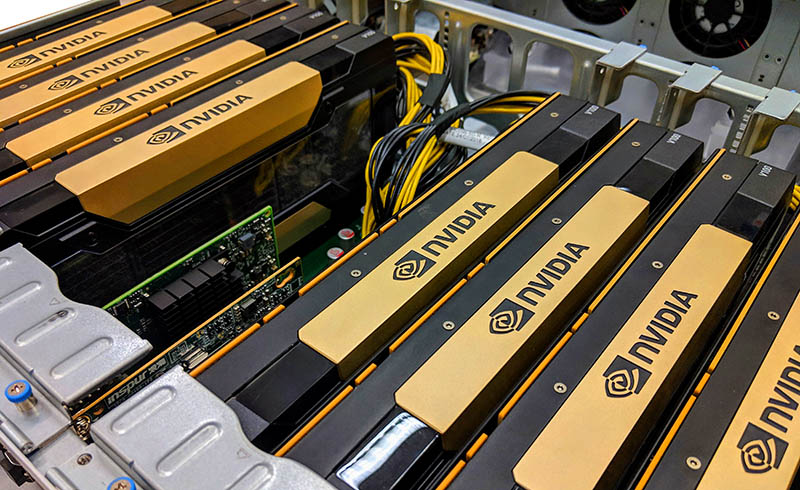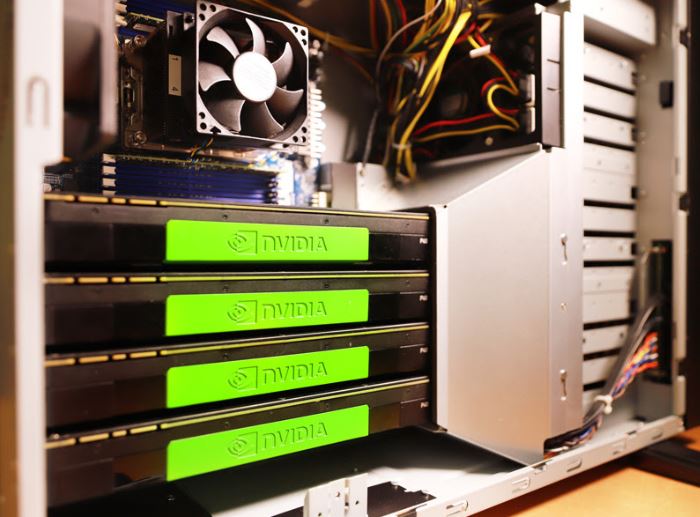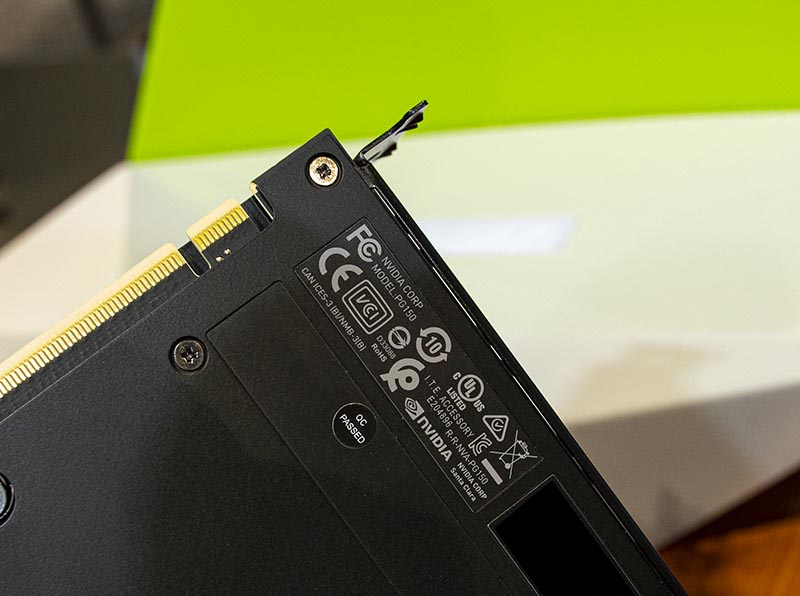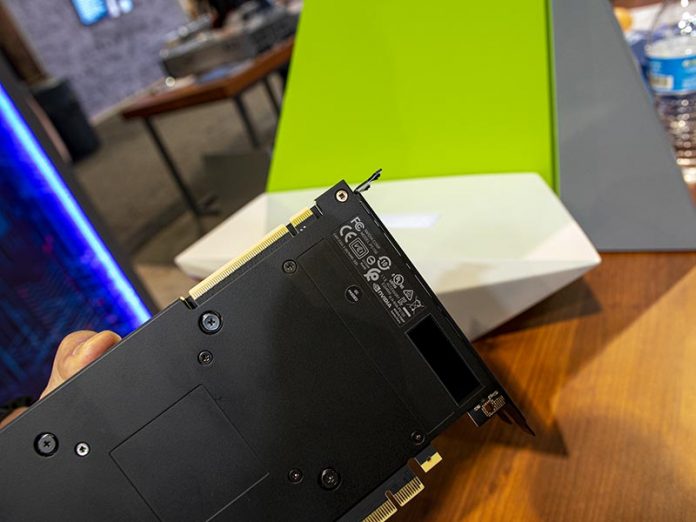One of the most interesting NVIDIA products we saw on the SC19 show floor was a green NVIDIA GPU. It turns out that it is a passively cooled NVIDIA PG150 GPU that is clearly meant for servers. This particular card stuck out on the SC19 show floor because it looked different than most of the others.
NVIDIA PG150 Passively Cooled GeForce RTX 2080 Ti
For some context, here are eight NVIDIA Tesla V100 GPUs from our Inspur Systems NF5468M5 Review:

What you will notice here is that the NVIDIA Tesla V100’s have the newer gold coloring on the passive heatsink casing. This particular card we spotted looked more like the older Tesla P100’s that were shown in the Gigabyte W291-Z00 stock photo (note our Gigabyte W291-Z00 Review used 4x Tesla V100’s):

At first, we thought this was not a big deal, but the single NVLink connector seemed out of place as it was the newer design with the older heatsink.
I took a photo of the identification bit of the card that was sitting on one of the show floor’s green NVIDIA display pedestals. The card’s heatsink did not say “P100” which every Tesla P100 I have seen clearly says. This seemed odd.

After the show, I went to look up what this could be and the NVIDIA PG150 is an NVIDIA GeForce RTX 2080 Ti board. When we cross-referenced that with our FE review which also was called a PG150 and that is the model for the FCC per the user guide.
It seems like there was a passively cooled NVIDIA GeForce RTX 2080 Ti on display at SC19, sitting on one of the NVIDIA featured pedestals.
Final Words
The most likely reason this made it to the show floor is that NVIDIA dropped cards off at almost every booth. At SC19, every OEM, VAR, and solution provider seemingly is a NVIDIA partner, which means a lot of cards need to be seeded for the show floor.
At the same time, I can guarantee that such a product would sell tens of thousands of units very quickly if it officially existed. As we showed with the DeepLearning11: 10x NVIDIA GTX 1080 Ti Single Root Deep Learning Server build, the GTX 1080 Ti was so popular that NVIDIA changed its CUDA EULA to prevent its large-scale datacenter deployment. Since I have seen multiple 1.5 meter high pallets of GeForce RTX 2080 Ti’s on data center loading docks, it seems the RTX 2080 Ti is still popular for deep learning and AI work given its awesome price/ performance ratio.
This was likely a mock-up product that nobody expected would get seen by someone who would notice the detail. Still, it is an absolutely tantalizing product that I would love to see NVIDIA actually make. Perhaps it could have an updated heatsink shroud though.





Patrick: definitely keep at this one as I want a blower version of the 2080TI directly from NVidia!!
I am currently holding out for the 2080Ti Super cards but this one would do fine as I want dual and/or quad gpu cards for ridiculous fp32 based monte carlo simulations!!
Currently running 1080ti and Totan Xp and I know the regular 2080ti is twice as fast for my monte carlo simulations.
So keep at it and convince Nvidia that they would sell many boatloads to developers and seed the continued dominance of NVidia for any HPC type of workload!!
I am pretty sure nvidia’s “not for data center usage” actually translates to “unreliable results due to lack of ecc memory”.
Also, I doubt it qualifies for passively cooled unless it can actually be used as it is in an arbitrary computer enclosure. This relies on the typical server chassis air-flow pattern to operate properly. It would overheat in a regular computer case, even with ample airflow. It requires specifically directed airflow.
The not for DC is in the CUDA EULA.
Passively cooled in the data center means an accelerator does not have a fan, not that no airflow is required. If you look at all accelerator specs, “Active” denotes an onboard fan while “Passive” denotes cooled by chassis airflow with no active fan onboard the accelerator.
Any known (or suspected) servers which had those PG150 GPUs included?
PG150 is the board code. In fact it was a RTX6000.
I still feel like a distinctive nomenclature is needed to differentiate between “ambient airflow” and “directed airflow” type of “passive cooling”. Probably because of the association between “passive cooled” and “completely silent”, which is the exact opposite of the typically unbearably noisy server chassis.
DGO – This is one where the entire server industry uses this nomenclature and has done so for many years. Hard to change.